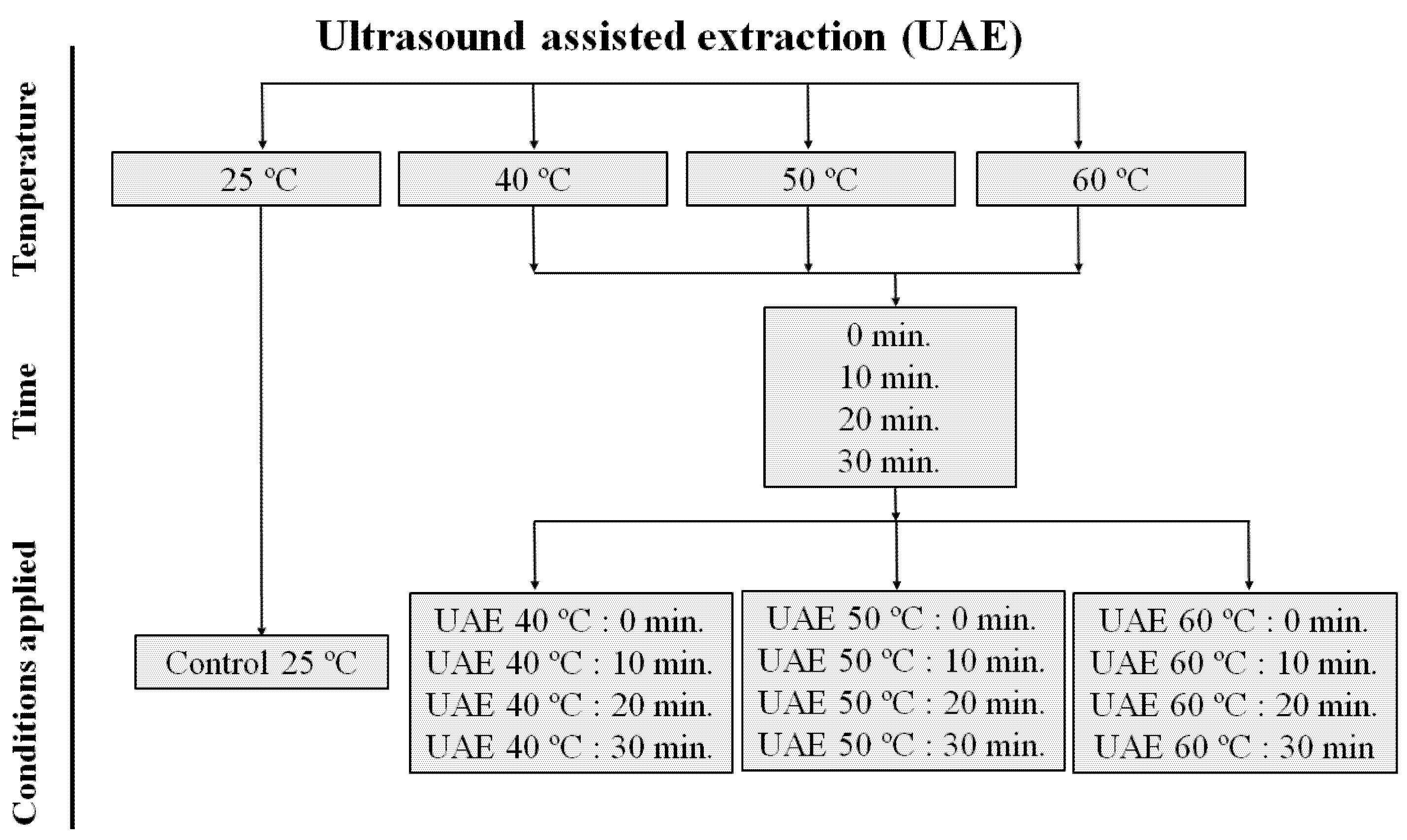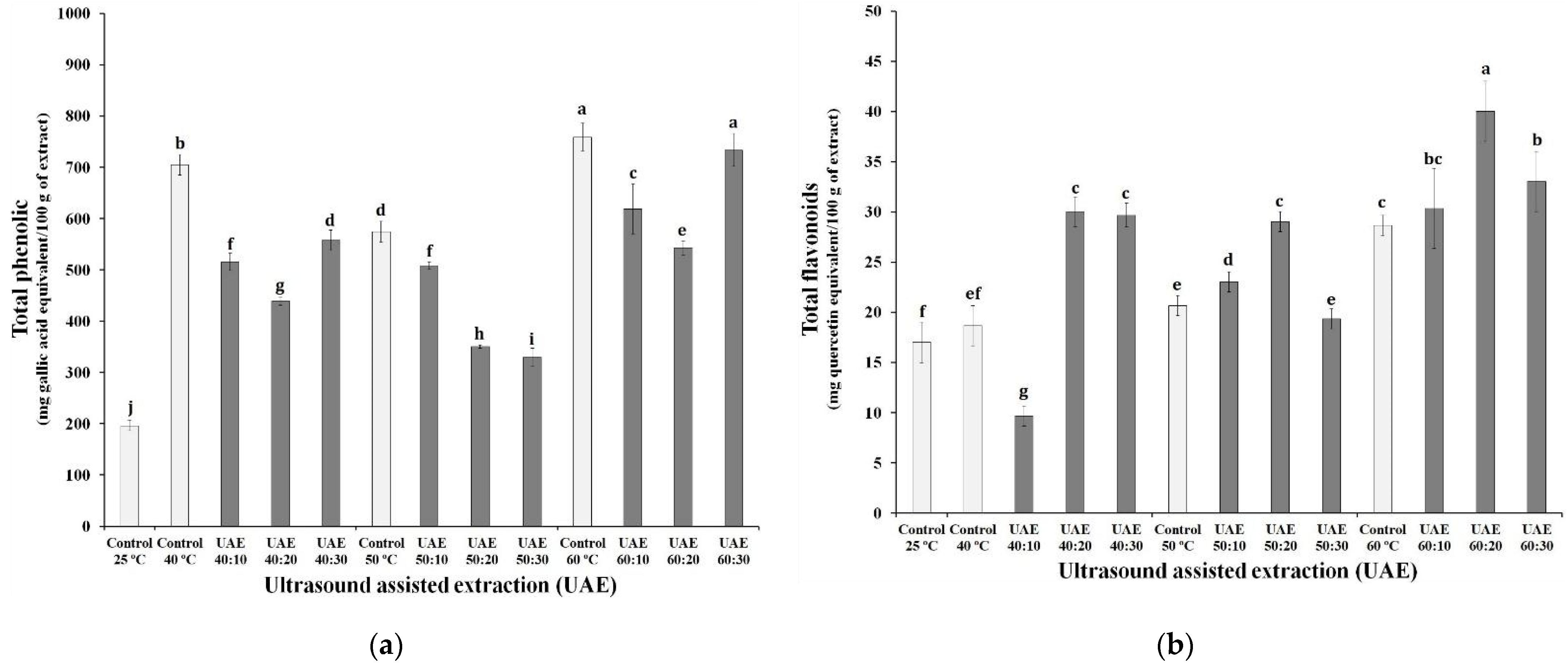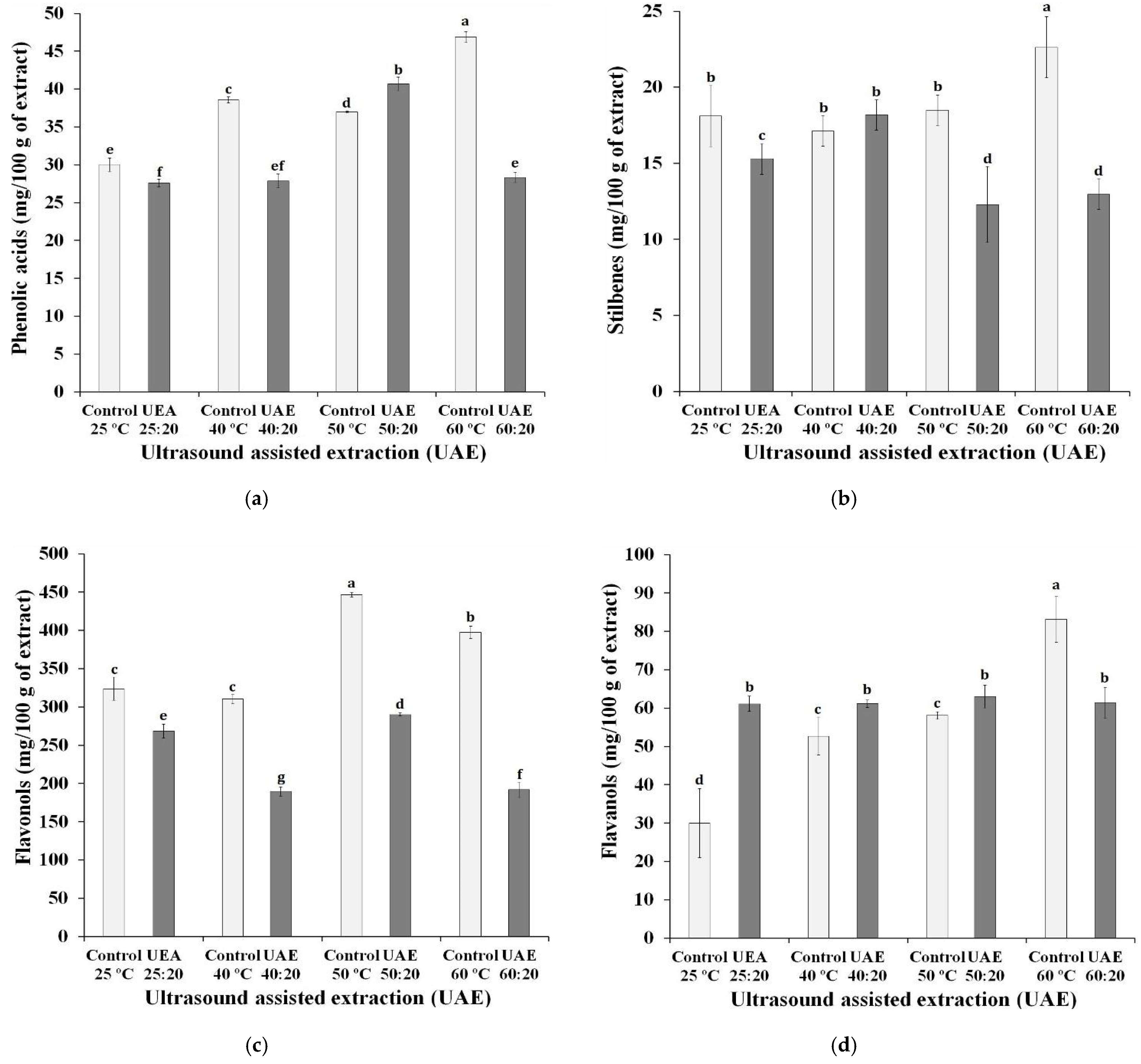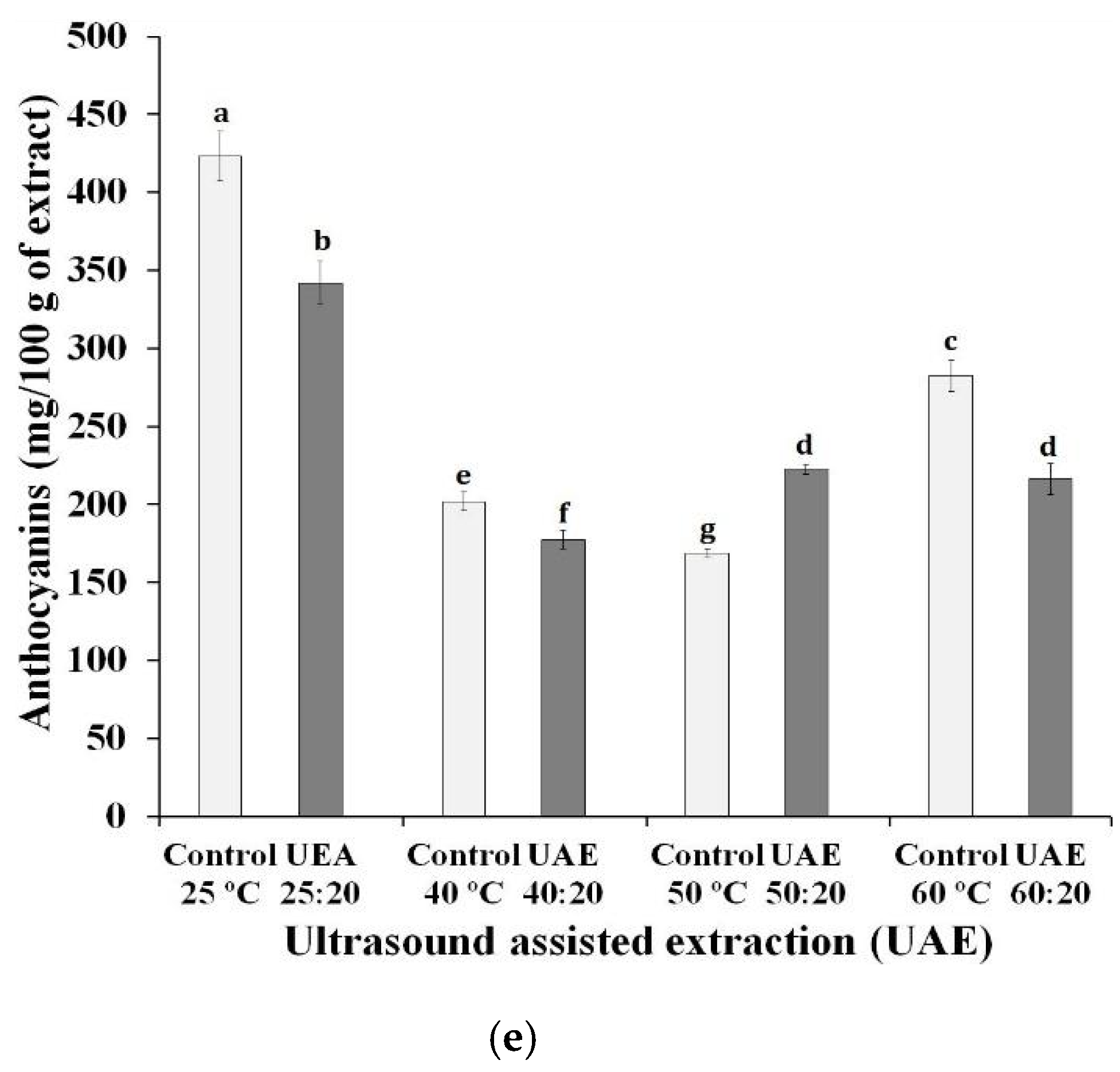Syrah Grape Skin Residues Has Potential as Source of Antioxidant and Anti-Microbial Bioactive Compounds
Abstract
:Simple Summary
Abstract
1. Introduction
2. Materials and Methods
2.1. Material and Reagents
2.2. Ultrasound-Assisted Extraction (UAE)
2.3. Total Phenolics and Flavonoids Content
2.4. Individual Phenolic Compounds by HPLC-DAD-FD
2.5. Antioxidant Activity
2.6. Antimicrobial Activity
2.7. Statistical Analysis
3. Results and Discussion
3.1. Bioactive Compounds by UAE from Syrah Var. Grape Skin Residue
3.2. Individual Bioactive Compounds by UAE from Syrah Var. Grape Skin Residue
3.3. Free Radical Scavenging Activity of Extracts Obtained from Syrah Var. Using UAE
3.4. Antimicrobial Activities of Extracts Obtained from Syrah Var. Using UAE
4. Conclusions
Author Contributions
Funding
Institutional Review Board Statement
Informed Consent Statement
Data Availability Statement
Conflicts of Interest
References
- Teixeira, A.; Baenas, N.; Dominguez-Perles, R.; Barros, A.; Rosa, E.; Moreno, D.A.; Garcia-Viguera, C. Natural bioactive compounds from winery by-products as health promoters: A review. Int. J. Mol. Sci. 2014, 15, 15638–15678. [Google Scholar] [CrossRef] [PubMed] [Green Version]
- Salehi, B.; Vlaisavljevic, S.; Adetunji, C.O.; Adetunji, J.B.; Kregiel, D.; Antolak, H.; Pawlikowska, E.; Uprety, Y.; Mileski, K.S.; Devkota, H.P.; et al. Plants of the genus Vitis: Phenolic compounds, anticancer properties and clinical relevance. Trends Food Sci. Technol. 2019, 91, 362–379. [Google Scholar] [CrossRef]
- Maicas, S.; Mateo, J.J. Sustainability of Wine Production. Sustainability 2020, 12, 559. [Google Scholar] [CrossRef] [Green Version]
- Ferri, M.; Bin, S.; Vallini, V.; Fava, F.; Michelini, E.; Roda, A.; Minnucci, G.; Bucchi, G.; Tassoni, A. Recovery of polyphenols from red grape pomace and assessment of their antioxidant and anti-cholesterol activities. New Biotechnol. 2016, 33, 338–344. [Google Scholar] [CrossRef]
- Fontana, A.R.; Antoniolli, A.; Bottini, R. Grape pomace as a sustainable source of bioactive compounds: Extraction, characterization, and biotechnological applications of phenolics. J. Agric. Food Chem. 2013, 61, 8987–9003. [Google Scholar] [CrossRef]
- Averilla, J.N.; Oh, J.; Kim, H.J.; Sik, J.K.; Kim, J.-S. Potential health benefits of phenolic compounds in grape processing by-products. Food Sci. Biotechnol. 2019, 17, 1607–1615. [Google Scholar] [CrossRef]
- Amorim, F.L.; Cerqueira Silva, M.B.; Cirqueira, M.G.; Oliveira, R.S.; Machado, B.A.S.; Gomes, R.G.; de Souza, C.O.; Druzian, J.I.; Souza Ferreira, E.; Umsza—Guez, M.A. Grape peel (Syrah var.) jam as a polyphenol—enriched functional food ingredient. Food Sci. Nutr. 2019, 7, 1584–1594. [Google Scholar] [CrossRef]
- da Silva, G.V.; Machado, B.A.S.; de Oliveira, W.P.; da Silva, C.F.G.; de Quadros, C.P.; Druzian, J.I.; Ferreira, E.d.S.; Umsza-Guez, M.A. Effect of Drying Methods on Bioactive Compounds and Antioxidant Capacity in Grape Skin Residues from the New Hybrid Variety “BRS Magna”. Molecules 2020, 25, 3701. [Google Scholar] [CrossRef]
- Jeandet, P.; Douillet-Breuil, A.-C.; Bessis, R.; Debord, S.; Sbaghi, M.; Adrian, M. Phytoalexins from the Vitaceae: Biosynthesis, Phytoalexin Gene Expression in Transgenic Plants, Antifungal Activity, and Metabolism. J. Agric. Food Chem. 2002, 50, 2731–2741. [Google Scholar] [CrossRef]
- Marina, G.C.; Samantha, S.C.; Josiane, D.V.; Carlos, A.B.C.S.; Marcelo, A.U.-G.; Bruna, A.S.M. Phytochemical importance and utilization potential of grape residue from wine production. Afr. J. Biotechnol. 2017, 16, 179–192. [Google Scholar] [CrossRef] [Green Version]
- Paulus, W. Phenolics. In Microbicides for the Protection of Materials; Springer: Dordrecht, The Netherlands, 1993; pp. 141–198. ISBN 978-94-011-2118-7. [Google Scholar]
- Filip, V.; Plocková, M.; Šmidrkal, J.; Špičková, Z.; Melzoch, K.; Schmidt, Š. Resveratrol and its antioxidant and antimicrobial effectiveness. Food Chem. 2003, 83, 585–593. [Google Scholar] [CrossRef]
- Katalinić, V.; Možina, S.S.; Skroza, D.; Generalić, I.; Abramovič, H.; Miloš, M.; Ljubenkov, I.; Piskernik, S.; Pezo, I.; Terpinc, P.; et al. Polyphenolic profile, antioxidant properties and antimicrobial activity of grape skin extracts of 14 Vitis vinifera varieties grown in Dalmatia (Croatia). Food Chem. 2010, 119, 715–723. [Google Scholar] [CrossRef]
- Silva, R.P.D.; Machado, B.A.S.; Barreto, G.d.A.; Costa, S.S.; Andrade, L.N.; Amaral, R.G.; Carvalho, A.A.; Padilha, F.F.; Barbosa, J.D.V.; Umsza-Guez, M.A.; et al. Antioxidant, antimicrobial, antiparasitic, and cytotoxic properties of various Brazilian propolis extracts. PLoS ONE 2017, 12, e0172585. [Google Scholar]
- Rivera, O.M.P.; Leos, M.D.S.; Solis, V.E.; Domínguez, J.M. Recent trends on the valorization of winemaking industry wastes. Curr. Opin. Green Sustain. Chem. 2021, 27, 100415. [Google Scholar] [CrossRef]
- Pedroza, M.A.; Carmona, M.; Pardo, F.; Salinas, M.R. Waste grape skins thermal dehydration: Potential release of colour, phenolic and aroma compounds into wine. CyTA-J. Food 2012, 10, 225–234. [Google Scholar] [CrossRef]
- Iuga, M.; Mironeasa, S. Potential of grape byproducts as functional ingredients in baked goods and pasta. Compr. Rev. Food Sci. Food Saf. 2020, 19, 2473–2505. [Google Scholar] [CrossRef] [PubMed]
- Falcão, J.S.; Sobral, T.S.; Cruz, L.F.S.; Philadelpho, B.O.; Santos, J.E.M.; Costa, J.A.V.; Druzian, J.I.; Ferreira, E.S. Protein-enriched umbu (Spondias tuberosa) jam prepared by supplementation with Spirulina sp. LEB-18. Braz. J. Dev. 2020, 6, 22714–22729. [Google Scholar] [CrossRef]
- Barba, F.J.; Brianceau, S. Effect of alternative physical treatments (Ultrasounds, Pulsed Electric Fields, and High-Voltage Electrical Discharges) on selective recovery of bio-compounds from fermented grape pomace. Food Bioprocess Technol. 2015, 8, 1139–1148. [Google Scholar] [CrossRef]
- Souza, R.d.C.; Machado, B.A.S.; Barreto, G.A.; Leal, I.L.; Anjos, J.P.; Umsza-Guez, M.A. Effect of experimental parameters on the extraction of grape seed oil obtained by low pressure and supercritical fluid extraction. Molecules 2020, 25, 1634. [Google Scholar] [CrossRef] [Green Version]
- Meini, M.-R.; Cabezudo, I.; Boschetti, C.E.; Romanini, D. Recovery of phenolic antioxidants from Syrah grape pomace through the optimization of an enzymatic extraction process. Food Chem. 2019, 283, 257–264. [Google Scholar] [CrossRef]
- Hogervorst, J.C.; Miljić, U.; Puškaš, V. Extraction of bioactive compounds from grape processing by-products. In Handbook of Grape Processing by-Products; Galanakis, C.M., Ed.; Elsevier: Amsterdam, The Netherlands, 2017; pp. 105–135. ISBN 978-0-12-809870-7. [Google Scholar]
- Awad, T.S.; Moharram, H.A.; Shaltout, O.E.; Asker, D.; Youssef, M.M. Applications of ultrasound in analysis, processing and quality control of food: A review. Food Res. Int. 2012, 48, 410–427. [Google Scholar] [CrossRef]
- Medina-Torres, N.; Ayora-Talavera, T.; Espinosa-Andrews, H.; Sánchez-Contreras, A.; Pacheco, N. Ultrasound assisted extraction for the recovery of phenolic compounds from vegetable sources. Agronomy 2017, 7, 47. [Google Scholar] [CrossRef]
- Medina-Meza, I.G.; Barbosa-Cánovas, G.V. Assisted extraction of bioactive compounds from plum and grape peels by ultrasonics and pulsed electric fields. J. Food Eng. 2015, 166, 268–275. [Google Scholar] [CrossRef]
- Bamba, B.S.B.; Shi, J.; Tranchant, C.C.; Xue, S.J.; Forney, C.F.; Lim, L.T. Influence of extraction conditions on ultrasound-assisted recovery of bioactive phenolics from blueberry pomace and their antioxidant activity. Molecules 2018, 23, 1685. [Google Scholar] [CrossRef] [PubMed] [Green Version]
- Singleton, V.L.; Rossi, J.A. Colorimetry of total phenolics with phosphomolybdic-phosphotungstic acid reagents. Am. J. Enol. Vitic. 1965, 16, 144–158. [Google Scholar]
- Chang, C.; Yang, M.; Wen, H.; Chern, J. Estimation of total flavonoid content in propolis by two complementary colorimetric methods. J. Food Drug Anal. 2002, 10, 178–182. [Google Scholar]
- Natividade, M.M.P.; Corrêa, L.C.; Souza, S.V.C.; Pereira, G.E.; Lima, L.C.O. Simultaneous analysis of 25 phenolic compounds in grape juice for HPLC: Method validation and characterization of São Francisco Valley samples. Microchem. J. 2013, 110, 665–674. [Google Scholar] [CrossRef] [Green Version]
- Brand-Williams, W.; Cuvelier, M.E.; Berset, C. Use of a free radical method to evaluate antioxidant activity. LWT-Food Sci. Technol. 1995, 28, 25–30. [Google Scholar] [CrossRef]
- Vodnar, D.C.; Călinoiu, L.F.; Dulf, F.V.; Ştefănescu, B.E.; Crişan, G.; Socaciu, C. Identification of the bioactive compounds and antioxidant, antimutagenic and antimicrobial activities of thermally processed agro-industrial waste. Food Chem. 2017, 231, 131–140. [Google Scholar] [CrossRef]
- Bucić-Kojić, A.; Sovová, H.; Planinić, M.; Tomas, S. Temperature-dependent kinetics of grape seed phenolic compounds extraction: Experiment and model. Food Chem. 2013, 136, 1136–1140. [Google Scholar] [CrossRef]
- Caldas, T.W.; Mazza, K.E.L.; Teles, A.S.C.; Mattos, G.N.; Brígida, A.I.S.; Conte-Junior, C.A.; Borguini, R.G.; Godoy, R.L.O.; Cabral, L.M.C.; Tonon, R.V. Phenolic compounds recovery from grape skin using conventional and non-conventional extraction methods. Ind. Crops Prod. 2018, 111, 86–91. [Google Scholar] [CrossRef]
- Irakli, M.; Chatzopoulou, P.; Ekateriniadou, L. Optimization of ultrasound-assisted extraction of phenolic compounds: Oleuropein, phenolic acids, phenolic alcohols and flavonoids from olive leaves and evaluation of its antioxidant activities. Ind. Crops Prod. 2018, 124, 382–388. [Google Scholar] [CrossRef]
- Planinic, M.; Aliakbarian, B.; Perego, P.; Greganic, K.; Tomas, S.; Bucic-Kojic, A. Influence of temperature and drying time on extraction yield of phenolic compounds from grape pomace variety “portogizac”. Chem. Biochem. Eng. Q. 2015, 29, 343–350. [Google Scholar] [CrossRef]
- Chamorro, S.; Viveros, A.; Alvarez, I.; Vega, E.; Brenes, A. Changes in polyphenol and polysaccharide content of grape seed extract and grape pomace after enzymatic treatment. Food Chem. 2012, 133, 308–314. [Google Scholar] [CrossRef] [PubMed] [Green Version]
- Wang, T.; He, F.; Chen, G. Improving bioaccessibility and bioavailability of phenolic compounds in cereal grains through processing technologies: A concise review. J. Funct. Foods 2014, 7, 101–111. [Google Scholar] [CrossRef]
- Giacometti, J.; Žauhar, G.; Žuvić, M. Optimization of ultrasonic-assisted extraction of major phenolic compounds from olive leaves (Olea europaea L.) using response surface methodology. Foods 2018, 7, 149. [Google Scholar] [CrossRef] [PubMed] [Green Version]
- Rodríguez-Pérez, C.; Quirantes-Piné, R.; Fernández-Gutiérrez, A.; Segura-Carretero, A. Optimization of extraction method to obtain a phenolic compounds-rich extract from Moringa oleifera Lam leaves. Ind. Crops Prod. 2015, 66, 246–254. [Google Scholar] [CrossRef]
- Corrales, M.; Toepfl, S.; Butz, P.; Knorr, D.; Tauscher, B. Extraction of anthocyanins from grape by-products assisted by ultrasonics, high hydrostatic pressure or pulsed electric fields: A comparison. Innov. Food Sci. Emerg. Technol. 2008, 9, 85–91. [Google Scholar] [CrossRef]
- Dal Magro, L.; Goetze, D.; Ribeiro, C.T.; Paludo, N.; Rodrigues, E.; Hertz, P.F.; Klein, M.P.; Rodrigues, R.C. Identification of Bioactive Compounds From Vitis labrusca L. Variety Concord Grape Juice Treated With Commercial Enzymes: Improved Yield and Quality Parameters. Food Bioprocess Technol. 2016, 9, 365–377. [Google Scholar] [CrossRef]
- Padilha, C.V.d.S.; Miskinis, G.A.; de Souza, M.E.A.O.; Pereira, G.E.; de Oliveira, D.; Bordignon-Luiz, M.T.; Lima, M.d.S. Rapid determination of flavonoids and phenolic acids in grape juices and wines by RP-HPLC/DAD: Method validation and characterization of commercial products of the new Brazilian varieties of grape. Food Chem. 2017, 228, 106–115. [Google Scholar] [CrossRef] [Green Version]
- Amorim, F.L.; de Cerqueira Silva, M.B.; Cirqueira, M.G.; Oliveira, R.S.; Machado, B.A.S.; Gomes, R.G.; de Souza, C.O.; Druzian, J.I.; de Souza Ferreira, E.; Umsza-Guez, M.A.; et al. Physicochemical analysis of Apple and Grape Pomaces. Food Chem. 2018, 10, 319–337. [Google Scholar] [CrossRef]
- Tournour, H.H.; Segundo, M.A.; Magalhães, L.M.; Barreiros, L.; Queiroz, J.; Cunha, L.M. Valorization of grape pomace: Extraction of bioactive phenolics with antioxidant properties. Ind. Crops Prod. 2015, 74, 397–406. [Google Scholar] [CrossRef]
- Casazza, A.A.; Aliakbarian, B.; Mantegna, S.; Cravotto, G.; Perego, P. Extraction of phenolics from Vitis vinifera wastes using non-conventional techniques. J. Food Eng. 2010, 100, 50–55. [Google Scholar] [CrossRef]
- Melo, P.S.; Massarioli, A.P.; Denny, C.; Dos Santos, L.F.; Franchin, M.; Pereira, G.E.; Vieira, T.M.F.D.S.; Rosalen, P.L.; De Alencar, S.M. Winery by-products: Extraction optimization, phenolic composition and cytotoxic evaluation to act as a new source of scavenging of reactive oxygen species. Food Chem. 2015, 181, 160–169. [Google Scholar] [CrossRef] [PubMed] [Green Version]
- Mulero, J.; Pardo, F.; Zafrilla, P. Journal of Food Composition and Analysis Antioxidant activity and phenolic composition of organic and conventional grapes and wines. J. Food Compos. Anal. 2010, 23, 569–574. [Google Scholar] [CrossRef]
- Sousa, E.C.; Uchôa-Thomaz, A.M.A.; Carioca, J.O.B.; de Morais, S.M.; de Lima, A.; Martins, C.G.; Alexandrino, C.D.; Ferreira, P.A.T.; Rodrigues, A.L.M.; Rodrigues, S.P.; et al. Chemical composition and bioactive compounds of grape pomace (Vitis vinifera L.), Benitaka variety, grown in the semiarid region of Northeast Brazil. Food Sci. Technol. 2014, 34, 135–142. [Google Scholar] [CrossRef] [Green Version]
- Lingua, M.S.; Fabani, M.P.; Wunderlin, D.A.; Baroni, M.V. In vivo antioxidant activity of grape, pomace and wine from three red varieties grown in Argentina: Its relationship to phenolic profile. J. Funct. Foods 2016, 20, 332–345. [Google Scholar] [CrossRef]
- Tiwari, B.K.; Patras, A.; Brunton, N.; Cullen, P.J.; O’Donnell, C.P. Effect of ultrasound processing on anthocyanins and color of red grape juice. Ultrason. Sonochem. 2010, 17, 598–604. [Google Scholar] [CrossRef]
- Tiwari, B.K.; O’Donnell, C.P.; Cullen, P.J. Effect of sonication on retention of anthocyanins in blackberry juice. J. Food Eng. 2009, 93, 166–171. [Google Scholar] [CrossRef]
- Li, F.X.; Li, F.H.; Yang, Y.X.; Yin, R.; Ming, J. Comparison of phenolic profiles and antioxidant activities in skins and pulps of eleven grape cultivars (Vitis vinifera L.). J. Integr. Agric. 2019, 18, 1148–1158. [Google Scholar] [CrossRef]
- Pinelo, M.; Arnous, A.; Meyer, A.S. Upgrading of grape skins: Significance of plant cell-wall structural components and extraction techniques for phenol release. Trends Food Sci. Technol. 2006, 17, 579–590. [Google Scholar] [CrossRef]
- Meng, J.F.; Fang, Y.L.; Qin, M.Y.; Zhuang, X.F.; Zhang, Z.W. Varietal differences among the phenolic profiles and antioxidant properties of four cultivars of spine grape (Vitis davidii Foex) in Chongyi County (China). Food Chem. 2012, 134, 2049–2056. [Google Scholar] [CrossRef] [PubMed]
- Baliga, M.S.; Katiyar, S.K. Chemoprevention of photocarcinogenesis by selected dietary botanicals. Photochem. Photobiol. Sci. 2006, 5, 243–253. [Google Scholar] [CrossRef] [Green Version]
- Rockenbach, I.I.; Gonzaga, L.V.; Rizelio, V.M.; Gonçalves, A.E.d.S.S.; Genovese, M.I.; Fett, R. Phenolic compounds and antioxidant activity of seed and skin extracts of red grape (Vitis vinifera and Vitis labrusca) pomace from Brazilian winemaking. Food Res. Int. 2011, 44, 897–901. [Google Scholar] [CrossRef]
- Fernández-Marín, M.I.; Guerrero, R.F.; García-Parrilla, M.C.; Puertas, B.; Ramírez, P.; Cantos-Villar, E. Terroir and variety: Two key factors for obtaining stilbene-enriched grapes. J. Food Compos. Anal. 2013, 31, 191–198. [Google Scholar] [CrossRef]
- Chen, Z.; Bertin, R.; Froldi, G. EC50 estimation of antioxidant activity in DPPH* assay using several statistical programs. Food Chem. 2013, 138, 414–420. [Google Scholar] [CrossRef]
- Xu, Y.; Burton, S.; Kim, C.; Sismour, E. Phenolic compounds, antioxidant, and antibacterial properties of pomace extracts from four virginia-grown grape varieties. Food Sci. Nutr. 2016, 4, 125–133. [Google Scholar] [CrossRef]
- Sridhar, K.; Charles, A.L. In vitro antioxidant activity of Kyoho grape extracts in DPPH and ABTS assays: Estimation methods for EC50 using advanced statistical programs. Food Chem. 2019, 275, 41–49. [Google Scholar] [CrossRef]
- Park, M.; Oh, J. Antioxidant and antimicrobial activities of muscadine grape extracts. Korean J. Food Preserv. 2015, 22, 12–18. [Google Scholar] [CrossRef]
- Doshi, P.; Adsule, P.; Banerjee, K.; Oulkar, D. Phenolic compounds, antioxidant activity and insulinotropic effect of extracts prepared from grape (Vitis vinifera L.) byproducts. J. Food Sci. Technol. 2015, 52, 181–190. [Google Scholar] [CrossRef] [Green Version]
- Antoniolli, A.; Fontana, A.R.; Piccoli, P.; Bottini, R. Characterization of polyphenols and evaluation of antioxidant capacity in grape pomace of the cv. Malbec. Food Chem. 2015, 178, 172–178. [Google Scholar] [CrossRef] [PubMed]
- Orak, H.H. Total antioxidant activities, phenolics, anthocyanins, polyphenoloxidase activities of selected red grape cultivars and their correlations. Sci. Hortic. 2007, 111, 235–241. [Google Scholar] [CrossRef]
- Yeo, K.L.; Leo, C.P.; Chan, D.J.C. Ultrasonic enhancement on propolis extraction at varied pH and alcohol content. J. Food Process Eng. 2015, 38, 562–570. [Google Scholar] [CrossRef]
- Oliveira, D.A.; Salvador, A.A.; Smânia, A.; Smânia, E.F.A.; Maraschin, M.; Ferreira, S.R.S. Antimicrobial activity and composition profile of grape (Vitis vinifera) pomace extracts obtained by supercritical fluids. J. Biotechnol. 2013, 164, 423–432. [Google Scholar] [CrossRef] [PubMed]
- Silici, S.; Kutluca, S. Chemical composition and antibacterial activity of propolis collected by three different races of honeybees in the same region. J. Ethnopharmacol. 2005, 99, 69–73. [Google Scholar] [CrossRef]
- Smith-Palmer, A.; Stewart, J.; Fyfe, L. Antimicrobial properties of plant essential oils and essences against five important food-borne pathogens. Lett. Appl. Microbiol. 1998, 26, 118–122. [Google Scholar] [CrossRef]





| Phenolic Compounds mg/100 g | Extracts ‡ | |||||||
|---|---|---|---|---|---|---|---|---|
| Control 25 °C | UAE 25:20 | Control 40 °C | UAE 40:20 | Control 50 °C | UAE 50:20 | Control 60 °C | UAE 60:20 | |
| Phenolic acids | ||||||||
| Gallic acid | 9.6 ± 0.1 b | <LQ | 9.3 ± 0.5 b | <LQ | 10.2 ± 0.0 ab | <LQ | 14.9 ± 0.3 a | <LQ |
| Caffeic acid | 7.3 ± 0.1 ab | 6.4 ± 0.1 b | 8.6 ± 0.1 ab | 6.8 ± 0.0 ab | 8.4 ± 0.0 ab | 8.2 ± 0.1 ab | 9.9 ± 0.2 a | 7.9 ± 0.2 ab |
| Caftaric acid | 17 ± 0.1 ab | 14.2 ± 0.4 b | 20.7 ± 0.3 ab | 13.9 ± 0.1 b | 18.4 ± 0.1 ab | 22.4 ± 0.5 a | 22.1 ± 0.2 a | <LQ |
| Stilbenes | ||||||||
| Cis-resveratrol | 3.5 ± 0.1 ab | 2.9 ± 0.0 b | 2.9 ± 0.0 b | 3.6 ± 0.0 ab | 3.2 ± 0.0 b | ND | 4.3 ± 0.0 a | 3.6 ± 0.0 ab |
| Trans-resveratrol | 5.5 ± 0.1 ab | 4.7 ± 0.0 b | 4.9 ± 0.2 b | 5.0 ± 0.0 b | 5.8 ± 0.0 ab | ND | 6.3 ± 0.0 a | ND |
| Viniferin | 9.1 ± 0.2 bc | 7.6 ± 0.0 c | 9.3 ± 0.3 bc | 9.5 ± 0.0 abc | 9.5 ± 0.0 abc | 10.4 ± 0.1 ab | 12.1 ± 0.2 a | 9.4 ± 0.0 bc |
| Flavanols | ||||||||
| (+)-Catechin | 14.9 ± 0.5 ab | 12.9 ± 0.2 b | 16.5 ± 0.4 ab | 13.7 ± 0.0 b | 16.0 ± 0.3 ab | 14.6 ± 0.4 ab | 23.0 ± 0.4 a | 14.8 ± 0.2 ab |
| Procyanidin B1 | 21.1 ± 0.4 ab | 18.4 ± 0.1 b | 20.2 ± 0.8 b | 22.5 ± 0.1 ab | 19.7 ± 0.4 b | 23.8 ± 0.2 ab | 27.1 ± 0.2 a | 22.5 ± 0.2 ab |
| Procyanidin B2 | 25.1 ± 0.5 ab | 21.4 ± 0.2 b | 24.4 ± 0.5 ab | 23.7 ± 0.1 b | 22.4 ± 0.3 b | 24.6 ± 0.4 ab | 33.0 ± 0.4 a | 24.0 ± 0.3 b |
| Flavonols | ||||||||
| Kaempferol-3-O-glucoside | 12.1 ± 0.3 a | 13.4 ± 0.4 a | 12.5 ± 0.2 a | 10.4 ± 0.0 a | 16.8 ± 0.1 a | 6.7 ± 0.4 a | 19.9 ± 0.5 a | 11.1 ± 0.3 a |
| Quercetin-β-D-glucoside | 199.1 ± 5.1 c | 177.4 ± 3.8 de | 187.7 ± 6.2 cd | 110.4 ± 4.4 f | 167.9 ± 2.8 e | 288.9 ± 3.2 a | 247.7 ± 2.7 b | 112.5 ± 0.4 f |
| Isorhamnetin-3-glucoside-chloride | 68.4 ± 0.3 c | 40.1 ± 0.3 d | 65.3 ± 0.2 c | 39.3 ± 0.2 d | 64.5 ± 0.1 c | 99.0 ± 0.1 b | 77.6 ± 0.1 b | 43.8 ± 0.2 d |
| Myricetin | 37.4 ± 0.4 abc | 29.8 ± 0.5 c | 39.6 ± 0.2 ab | 17.7 ± 0.1 d | 34.1 ± 0.2 bc | 33.5 ± 0.3 bc | 43.9 ± 0.3 a | 16.2 ± 0.3 d |
| Rutin | 6.7 ± 0.2 ab | 7.4 ± 0.1 ab | 5.1 ± 0.1 b | 7.6 ± 0.0 ab | 6.9 ± 0.1 ab | 8.4 ± 0.1 ab | 8.7 ± 0.1 a | 8.4 ± 0.2 ab |
| Anthocyanins | ||||||||
| Malvidin-3-glucoside-chloride | 324.5 ± 3.2 a | 259.8 ± 1.5 b | 150.0 ± 6.4 d | 118.8 ± 5.2 e | 121.6 ± 2.9 e | 157.5 ± 3.3 d | 203.3 ± 3.8 c | 159.8 ± 5.3 d |
| Cyanidin-3-glucoside-chloride | 5.5 ± 0.1 ab | 4.8 ± 0.0 bc | 5.1 ± 0.2 bc | 5.8 ± 0.0 ab | 4.3 ± 0.1 c | 6.4 ± 0.0 a | 6.9 ± 0.0 a | ND |
| Pelargonidin-3-glucoside-chloride | 41.2 ± 0.5 a | 33.8 ± 0.5 ab | 21.9 ± 0.2 cd | 19.6 ± 0.1 d | 18.6 ± 0.1 d | 23.9 ± 0.1 cd | 28.0 ± 0.1 bc | 25.5 ± 0.1 cd |
| Delfinidine-3-O-glucoside | 17.4 ± 0.3 a | 12.4 ± 0.4 abc | 10.9 ± 0.2 bc | 11.0 ± 0.1 abc | 9.3 ± 0.1 c | 10.3 ± 0.2 bc | 16.0 ± 0.2 ab | 11.5 ± 0.2 abc |
| Peonidine-3-O-glucoside | 34.2 ± 0.5 a | 31.1 ± 0.2 a | 13.8 ± 0.3 d | 22.0 ± 0.1 bc | 14.7 ± 0.1 d | 24.6 ± 0.2 bc | 28.1 ± 0.2 ab | 19.5 ± 0.1 cd |
| Variables | EC50 | Total Flavonoid Content | Malvidin-3-Glucoside-Chloride | Total Anthocyanins | Total Phenolic Content | Procyanidin B2 |
|---|---|---|---|---|---|---|
| EC50 | - | −0.737 (<0.0001) | 0.480 (0.018) | 0.454 (0.026) | - | - |
| Total flavonoid content | −0.737 (<0.0001) | - | −0.478 (0.018) | −0.457 (0.025) | 0.441 (0.031) | - |
| Malvidin-3-glucoside-chloride | 0.480 (0.018) | −0.478 (0.018) | - | 0.996 (<0.0001) | −0.657 (0.000) | - |
| Anthocyanins | 0.454 (0.026) | −0.457 (0.025) | 0.996 (<0.0001) | - | −0.649 (0.001) | - |
| Total phenolic content | - | 0.441 (0.031) | −0.657 (0.000) | −0.649 (0.001) | - | 0.451 (0.027) |
| Procyanidin B2 | - | - | - | - | 0.451 (0.027) | - |
Publisher’s Note: MDPI stays neutral with regard to jurisdictional claims in published maps and institutional affiliations. |
© 2021 by the authors. Licensee MDPI, Basel, Switzerland. This article is an open access article distributed under the terms and conditions of the Creative Commons Attribution (CC BY) license (https://creativecommons.org/licenses/by/4.0/).
Share and Cite
de Andrade, R.B.; Machado, B.A.S.; Barreto, G.d.A.; Nascimento, R.Q.; Corrêa, L.C.; Leal, I.L.; Tavares, P.P.L.G.; Ferreira, E.d.S.; Umsza-Guez, M.A. Syrah Grape Skin Residues Has Potential as Source of Antioxidant and Anti-Microbial Bioactive Compounds. Biology 2021, 10, 1262. https://doi.org/10.3390/biology10121262
de Andrade RB, Machado BAS, Barreto GdA, Nascimento RQ, Corrêa LC, Leal IL, Tavares PPLG, Ferreira EdS, Umsza-Guez MA. Syrah Grape Skin Residues Has Potential as Source of Antioxidant and Anti-Microbial Bioactive Compounds. Biology. 2021; 10(12):1262. https://doi.org/10.3390/biology10121262
Chicago/Turabian Stylede Andrade, Roberta Barreto, Bruna Aparecida Souza Machado, Gabriele de Abreu Barreto, Renata Quartieri Nascimento, Luiz Claudio Corrêa, Ingrid Lessa Leal, Pedro Paulo Lordelo Guimarães Tavares, Ederlan de Souza Ferreira, and Marcelo Andrés Umsza-Guez. 2021. "Syrah Grape Skin Residues Has Potential as Source of Antioxidant and Anti-Microbial Bioactive Compounds" Biology 10, no. 12: 1262. https://doi.org/10.3390/biology10121262








